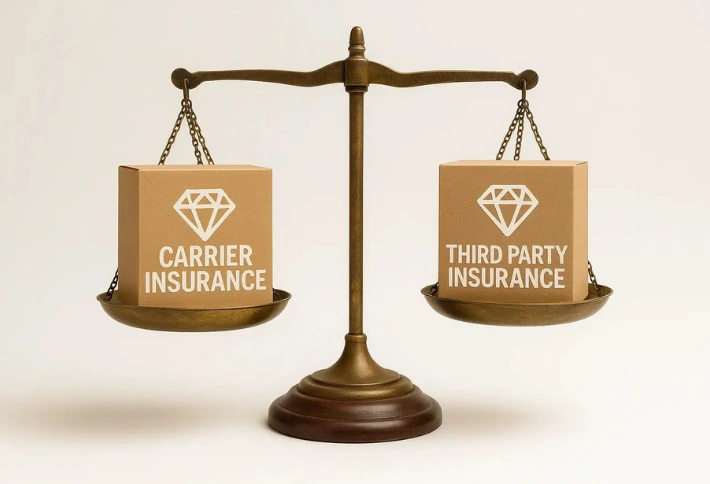In a world where online purchases are becoming the norm, delivery delays, package damage, or lost packages can seriously impact customer satisfaction and your bottom line. That’s where shipping insurance steps in. If you’ve ever asked yourself, ‘What is shipping insurance?’ and whether it’s worth the additional cost, this guide is for you.
What Is Shipping Insurance
Shipping insurance is a service that reimburses the shipper or buyer if a package is lost, stolen, or damaged during transit. It applies to both domestic and international shipments.
This coverage is especially important for high-value or fragile goods, as it reduces the risk of profit loss. Many shipping insurance companies offer flexible coverage plans tailored to ecommerce shipping insurance needs, including protection for bulk orders, recurring shipments, and overseas deliveries.
How Does Shipping Insurance Work

When you purchase insurance for shipping goods, the provider assumes financial liability if the shipment doesn’t arrive safely. It works like this:
- You declare the package’s value when creating the shipping label. This amount would normally be more than the built-in coverage provided by the carrier (typically $100 or $150). Insurance is applied via the carrier or a 3rd party shipping insurance provider.
- If an issue occurs (loss, damage, theft), you file a claim.
- Upon approval, the carrier pays the built-in coverage, and the rest of the insured value amount is paid by the insurance carrier.
How to Insure a Package
To insure a package:
- Select insurance at checkout (if using USPS, UPS, FedEx, or DHL).
- Select whether you want to purchase insurance from the carrier or a third-party shipping provider such as OrderCup.
- Specify the insured value and retain proof of contents.
- Photograph packaging for potential claim evidence.
Typically, most leading carriers, such as UPS or FedEx, provide some level of default insurance coverage (up to $100 or $150). If you have a higher level of coverage, you would have to insure it for a higher amount, and this would be at an additional cost.
What Does Shipping Insurance Cover (and What It Doesn’t)

Shipping insurance typically covers three core areas: loss, theft, and damage. If a package goes missing in transit, arrives in a damaged condition, or is stolen before delivery, an insured shipment allows the sender to recover the insured value through a claims process. This offers a safety net for sellers who deal with fragile items, high-value goods, or high level of losses due to the reasons above.
However, not every insurance claim is approved and so it is important to have the proper backup to support the claim.. Shipping insurance usually does not reimburse for losses due to improper packaging, restricted or prohibited items, or shipment delays. Most shipping insurance companies require proof of value and appropriate packaging methods, and coverage may be denied if those conditions aren’t met.
Understanding the exclusions in your package insurance policy is critical to ensuring your claim won’t be rejected. Reviewing your carrier or third-party shipping insurance policy to understand their coverage terms and conditions, limits, and exceptions helps avoid claim denial.
Carrier [USPS, UPS, FedEx, DHL] Shipping Insurance

Each carrier offers standard and additional coverage:
Cost and terms of UPS Shipping Insurance
UPS provides declared value coverage, which is not traditional insurance but offers limited liability for loss or damage.
- Included Coverage: Up to $100 declared value per package at no additional charge.
- Additional Coverage: For values exceeding $100, the cost is $1.05 per $100 of declared value, up to a maximum of $50,000 per package.
- Service Variations: The declared value coverage applies uniformly across UPS services, including UPS Ground, UPS Next Day Air, and international services.
- Specialized Insurance: For shipments requiring higher coverage or specialized insurance, UPS offers InsureShield® through UPS Capital, providing comprehensive protection against loss, damage, and delay.
Cost and terms of USPS Shipping Insurance
USPS offers varying levels of included insurance based on the mail class, with options to purchase additional coverage.
- Included Coverage for Priority Mail Express, Priority Mail, and USPS Ground Advantage: Up to $100 included.
- Additional Coverage: Available up to $5,000, with fees based on the declared value and starts at $2.50 per $100 value. [1]
- Service Variations: Insurance availability and limits can vary by service. [1]
Cost and terms of FedEx Shipping Insurance
FedEx provides declared value coverage, which is not insurance but sets a limit of liability for loss or damage.
- Included Coverage: Up to $100 declared value per shipment at no additional charge. [2]
- Additional Coverage:
FedEx SameDay and SameDay City: Maximum declared value of $2,000; additional cost is $3 for shipments up to $300, then $1.25 per $100 over $300.
FedEx Express, FedEx Ground, and International Services: Additional cost is $3.90 for shipments valued up to $300, then $1 per $100 over $300.
- Service Variations: Maximum declared value limits and rates vary by service type.
- Specialized Coverage: For high-value items like jewelry or electronics, FedEx offers the Declared Value Advantage program, allowing for higher declared values with specific terms.
Cost and terms of DHL International Shipping Insurance
DHL offers optional Shipment Value Protection, which is separate from its limited default liability. This insurance covers the full declared value of your shipment in the event of physical loss or damage from external causes during transit.
- Default Coverage: Up to $35/kg for air shipments [3] and $11/kg for road transport [4] (automatically included, limited liability).
- Optional Insurance Cost: Starts at $10.50 for coverage up to $700 USD. Beyond that, it’s $1.50 per additional $100 of declared value.[5]
- High-Value Shipments: Shipments valued over $500,000 USD require prior approval.[6]
- Service Variation: Coverage limits and pricing may vary by country and service level.
Carrier Shipping Insurance Rates Compared: USPS, UPS, FedEx, DHL
| Carrier | Service | Included Coverage | Additional Coverage | Maximum Coverage |
| UPS | All Services | $100 | $1.05 per $100 over $100 | $50,000 |
| USPS | Priority Mail Express® | $100 | Varies by value | $5,000 |
| Priority Mail® | $100 | Varies by value | $5,000 | |
| USPS Ground Advantage® | $100 | Varies by value | $5,000 | |
| FedEx | SameDay®/SameDay City® | $100 | $3 up to $300, then $1.25 per $100 | $2,000 |
| Express®, Ground®, International | $100 | $3.90 up to $300, then $1 per $100 | Varies | |
| DHL | International Services | Varies by country | $10.50 up to $700, then $1.50 per $100 | Requires pre-approval > $500K |
Please note that the availability and terms of shipping insurance can vary based on the specific service level and destination. It’s advisable to consult the respective carrier’s official resources or customer service for the most accurate and up-to-date information.
Carrier vs 3rd Party Shipping Insurance: What’s the Difference

Carrier shipping insurance is included with most major carriers and often covers up to $100 in declared value. It’s convenient, but usually comes with limited coverage and stricter rules. Claims may take longer to process, and payout amounts may be lower, especially for ecommerce shipping insurance needs.
3rd party shipping insurance offers more flexibility. It often covers more situations—like porch theft, lost international parcels, and fragile items—and can work across multiple carriers. These providers typically offer better shipping insurance rates, faster claims, and broader protection.
If you’re insuring high-value items, using international shipping insurance, or need more reliable shipment protection, third-party shipping is often the better option.
OrderCup provides both carrier and its own shipping insurance (via its third-party insurance partner) directly through its platform. With OrderCup insurance, you get several benefits including a simple interface to both insure and file claims [irrespective of the carrrier], and shipping insurance rates that are 40 to 60% less than carrier insurance rates.
How to Choose the Right Shipping Insurance Provider
When evaluating shipping insurance companies:
- Look for flexible plans
- Review claim approval rates
- Check coverage for international shipments
- Compare cost vs. coverage depth
If you’re shipping insurance for high-value items or using ecommerce shipping platforms, a dedicated 3rd party insurer may be the best shipping insurance solution.
Conclusion: Is Shipping Protection Worth It
So, is shipping protection worth it? For most ecommerce sellers: yes. With rising delivery volumes, the risk of package loss or damage is higher than ever. The cost of shipping insurance is minimal compared to the potential loss in revenue and customer trust. However, in the case of low-value items or very low rates of loss, the additional cost of shipping insurance may not make sense. It may therefore make sense to selectively insure shipments (e.g. international shipments or shipments above a certain threshold) or not insure at all.
Understanding shipping insurance and choosing the right kind of shipping insurance is a proactive step in retail logistics. Whether you rely on DHL, USPS, UPS, or FedEx shipping insurance or 3rd party shipping insurance, coverage can save you time, stress, and money.
FAQs About Shipping Insurance
Who pays for shipping insurance?
Either the shipper or the customer can cover the cost. If the shipper is insuring the shipment, it is generally included in the cost of the items or in the shipping and handling fees, If you are asking the customer to pay for the shipping insurance, you would generally have to provide an option for them to opt in for the insurance coverage.
How do I claim shipping insurance?
Submit documentation (photos, receipts, proof of damage or non-delivery) to the insurer within the required time frame. Each carrier has its own rules and guidelines and process for handling claims. With OrderCup’s integrated shipping insurance, you can initiate the claim and monitor the status of your claim from right within our platform.
Is insurance mandatory for shipping?
No. But it’s strongly advised for valuable, fragile, or international orders.
Does shipping insurance protect the buyer or seller?
It generally protects the shipper (seller), but policies vary. Parcel insurance through a platform like Red Stag or InsureShield can include buyer coverage.
What happens if a carrier loses my package without insurance?
All major carriers—USPS, UPS, FedEx, and DHL—only cover shipments up to the insured amount. If your package isn’t insured and the service used doesn’t include default coverage, you may not receive any compensation for loss or damage. Coverage varies by service type, so it’s important to confirm what’s included before shipping.
Do carriers actually pay out insurance claims?
Yes, carriers like USPS, UPS, FedEx, and DHL do pay out claims when properly filed with supporting documentation such as proof of value and shipment. However, delays or denials can occur if paperwork is incomplete, deadlines are missed, or the claim doesn’t meet the service’s terms. Accurate and timely documentation is key.




